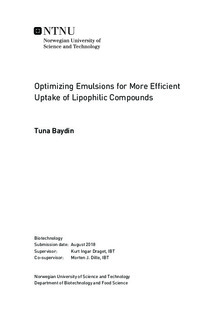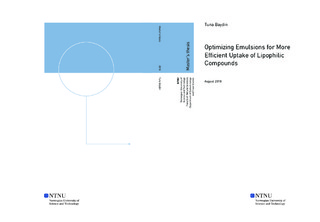| dc.description.abstract | Lipid based oral drug delivery systems provide a spectrum of formulations for the delivery of poorly water soluble compounds. When naturally occurring lipid molecules are utilized in these systems, in addition to being biodegradable and biocompatible, lipid based oral drug delivery systems may improve the solubility, absorption, bioavailability and pharmaceutical stability of the lipophilic molecules they carry. Pre-emulsified systems were shown to increase the bioavailability of lipophilic compounds, compared to bulk oil systems in vivo. This increase was suggested to be due to enhanced lipolysis/uptake of the emulsions compared to bulk oil carriers. In this study, we optimized emulsions regarding droplet size and oil type parameters. The aim of this optimization was to increase the bioavailability of lipophilic molecules such as nutraceuticals, biologics and pharmaceuticals.
A range of corn oil, olive oil and coconut oil emulsions, with D[4,3] volume means ranging from 15.800 μm to 0.208 μm were prepared by combining different surfactant (T80) concentrations and homogenizing methods (High-speed mixing and high-pressure homogenizer Star Burst). Despite exceptions, the D[4,3] volume means and the D[3,2] surface means of emulsions prepared with different oil types were different when the T80 concentrations were kept constant. The long term stability of all prepared emulsions was tested upon storage at +4° C and room temperature. Starbursted (2%, 1%, 0.5% and 0.25% T80) corn oil emulsions and Vitamin D3 K3 containing corn oil emulsions (2% and 1% T80) exhibited coalescing oil droplets on the surface when stored at +4°C but not at room temperature. Olive oil emulsions showed solid creaming on the surface or color change when stored at +4°C, but not at room temperature. Coconut oil emulsions crystallized and therefore, were less stable when stored at +4°C, compared to room temperature.
In vitro lipolysis of (starbursted 2%, 1%, 0.5%, 0.25% T80 and non-starbursted 2% T80) corn oil emulsions was enzyme limited with 0.4 mg/ml pancreatin. With 1.2 mg/ml pancreatin and lipase, among (starbursted 8%, 4%, 2%, 1%, 0.5%, 0.25% T80 and non-starbursted 2% T80) corn oil emulsions starbursted 2% T80 emulsion showed the highest in vitro lipolysis rate with 0.0708 mmol FA/min. When different oil type emulsions (starbursted 2% and 0.25% T80 and non-starbursted 2% T80) were subjected to in vitro lipolysis, coconut oil resulted in the highest lipolysis rate, compared to corn oil and olive oil. In the Back-Titration experiments, coconut oil required 21% and 25% more NaOH to be completely titrated at pH 10, compared to corn oil and olive oil, respectively. At pH 7, 74% of the fatty acids of coconut oil were deprotonated, whereas this number was 55% and 64% for corn oil and olive oil, respectively.
For the in vivo experiments, three corn oil emulsions containing vitamin D3 and vitamin E with different droplet sizes (starbursted 2% and 0.25% T80 and non-starbursted 2% T80) and a non-pre-emulsified pure corn oil system were prepared. Vitamin D3 E containing starbursted corn oil emulsions were stable upon long term storage at +4°C. These systems were fed to rats in a single dose after being freshly prepared. The pharmacokinetics of vitamin D3, 25-OH-vitamin D3, i.e. the circulating form of vitamin D3, and vitamin E were studied by collecting blood samples from rats at 7 time points (0h, 1h, 2h, 4h, 6h, 8h and 24h), isolating plasma from the blood samples and analyzing the plasma samples with UHPLC MS/MS after solid phase extraction. Vitamin E could not be analyzed with the currently developed solid phase extraction method. Upon preliminary inspection of the vitamin D3 concentration in rat plasma vs time, highest Cmax, Tmax and AUC24 values of vitamin D3 were obtained with 0.25% T80 corn oil emulsion. However, ANOVA test revealed no significant difference between the Cmax means of different feed systems. With the current experiment set up, Tmax and Cmax were not reached for 25-OH-vitamin D3, suggesting that the enzymatic conversion of vitamin D3 to 25-OH-vitamin D3 form was the rate limiting step. | |

